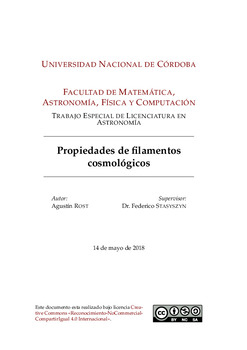| dc.contributor.advisor | Stasyszyn, Federico Andrés, dir. | |
| dc.contributor.author | Rost, Agustín Matías | |
| dc.date.accessioned | 2018-05-29T16:11:49Z | |
| dc.date.available | 2018-05-29T16:11:49Z | |
| dc.date.issued | 2018-05-14 | |
| dc.identifier.uri | http://hdl.handle.net/11086/6246 | |
| dc.description | Tesis (Lic. en Astronomía)--Universidad Nacional de Córdoba, Facultad de Matemática, Astronomía, Física y Computación, 2018. | es |
| dc.description.abstract | Los filamentos cosmológicos son estructuras del Universo con propiedades y comportamientos propios. Se realizó un estudio de las propiedades de estos objetos utilizando 3 catálogos de filamentos identificados con diferentes algoritmos en diferentes relevamientos del Sloan Digital Sky Survey (SDSS). Se demostró la importancia de cómo varían las propiedades y características de los mismos al utilizar distintos catálogos y cómo cada algoritmo lleva implícitamente una definición de filamento cosmológico. Las propiedades estudiadas fueron la distribución del número de galaxias y luminosidades de los filamentos, relaciones entre la sobredensidad, luminosidad por megapársec (Mpc) cúbico y longitudes, perfiles de los filamentos totales y separados por color, y el rol de la longitud de filamentos sobre la fracción de galaxias rojas.
Se verificó que al igual que con los cúmulos, en el centro de los filamentos hay una mayor proporción de galaxias rojas. Y al mismo tiempo, los filamentos más cortos tienden a tener una proporción mayor de galaxias rojas.
Concluimos también que los filamentos detectados usando un algoritmo basado en geometría tienen radios más pequeños.
Por otro lado, los filamentos detectados teniendo en cuenta la física, tienen radios más grandes. | es |
| dc.description.abstract | Cosmological filaments are objects of the web-like structure of the Universe.
A study on the properties of these objects has been done using a variety of methods. We used three filament catalogs determined with different algorithms from the SDSS (Sloan Digital Sky Survey) releases. We demonstrated that properties and characteristics of filaments are strongly dependent of the method or algorithm used to detect them.
We studied properties like the distribution of the number of galaxies and luminosities of filaments, the relation length-overdensity, length-luminosity per cubic Mpc, as well as the total radial density profile of filaments and the radial density profile separated by color. Another property studied is the relation between length and fraction of red galaxies within filaments.
We found that filaments detected using an algorithm based on
geometrical assumptions have narrow distributions of galaxies. On the other hand, those that were detected by algorithms that take into account other factors including the luminosity of galaxies have a wider density profile.
Other properties, the distributions of red and blue galaxies, were found to be different to each other: red galaxies are
concentrated near the center of the filament, while blue galaxies lie in regions with lower density, analogous to the galaxy distribution in galaxy clusters.
We conclude that properties of filaments are strongly related to the method used to detect them, because there is an intrinsic definition of filament according to each algorithm. | en |
| dc.language.iso | spa | es |
| dc.rights | Atribución-NoComercial-CompartirIgual 4.0 Internacional | * |
| dc.rights.uri | http://creativecommons.org/licenses/by-nc-sa/4.0/ | * |
| dc.subject | Supercúmulos - Estructura en gran escala del Universo | es |
| dc.subject | Superclusters - Large-scale structure of the Universe | en |
| dc.subject.other | Apilamiento | es |
| dc.subject.other | Filamentos cosmológicos | es |
| dc.subject.other | Stacking | en |
| dc.subject.other | SDSS | en |
| dc.title | Propiedades de filamentos cosmológicos | es |
| dc.type | bachelorThesis | es |





